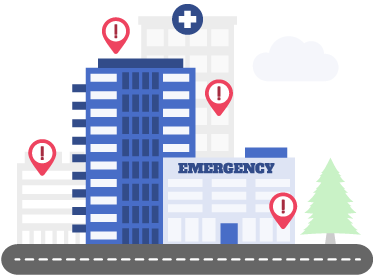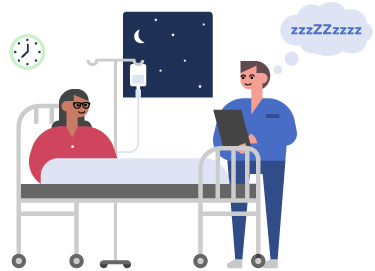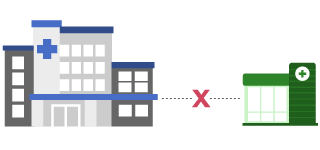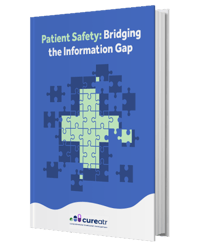Our guide covers why patient safety is important in hospitals, a nurse's role, how to handle patient safety during an emergency, the role technology plays, and more. Read the guide below or enter your email to download your copy to take on the go.

Take a moment and think about why it's important to deliver safe care to patients. First and foremost, patients go to a healthcare provider expecting to receive treatment that hopefully improves their health. At a minimum, this experience shouldn't make their health worse.
In recent years, patient safety has become even more important. Reimbursement is now directly tied to medical errors. Harm patients and watch insurers — federal and commercial — deny, adjust, or retract reimbursement. Poor patient satisfaction scores can lead to reimbursement penalties for some organizations. Healthcare review websites and social media provide platforms for patients to share stories about negative experiences and vent frustrations about care that failed to meet their expectations. These can influence where other patients choose to receive treatment. Word of patient harm travels quickly, sometimes picked up by local media and even national media, if the incident is severe enough.
These factors should serve as compelling reasons for healthcare organizations to prioritize efforts to improve their delivery of safe, high-quality care. The analysis that follows in this guide provides extensive guidance on patient safety. Hopefully the insight and resources shared will help your organization elevate its performance.

It’s crucial for healthcare providers to put themselves in their patients' shoes. Imagine how patients feel arriving at a hospital they didn’t choose while also feeling anxious about the reason they are there: a problem with their health.
An even greater concern is the fear that the care they receive will not help them but make matters worse. As a U.S. Senate committee hearing highlighted, more than 1,000 people die every day due to a preventable error.
The problem goes beyond any individual healthcare provider, but rather exists throughout the healthcare system. What does all this mean for your organization or facility? It’s essential to prioritize and create a culture of patient safety.
Creating such a culture must start at the top. Hospital leadership should not only implement policies and procedures that promote patient safety, but also focus on creating an environment where patient safety is embraced throughout the organization.
To be successful, any good patient safety initiative needs to begin with well-defined goals. If you’re not quite sure where to begin, consider reviewing the Joint Commission’s 2018 National Patient Safety Goals.
Ultimately, a patient safety initiative is designed to improve patient safety by focusing on problems in the delivery of safe care and their solutions. By setting measurable and attainable goals, hospitals can lower their 30-day readmission rate, increase employee morale, and forge a name for themselves as world-class institutions in healthcare. Most importantly, population health will improve and more lives will be saved as a result.
As we touched on in the previous section, developing patient safety goals is critical to reducing readmission rates and improving organization-wide patient safety.
To further explore the best way to develop goals for your healthcare organization, review the Joint Commission’s National Patient Safety Goals for 2018.

1. Identify Patients Correctly — This goal necessitates clear communication, which allows for doctors to provide the correct medications and treatment.

2. Improve Staff Communication — By implementing this goal, you will help improve compliance with many of the other advised goals.

3. Use Medicines Safely — A few ways to work toward achieving this goal include proper labeling of medicines and paying attention to which medicines your patients are taking.
Improve your organization's efforts to meet the remaining goals' requirements through new directives and enhanced guidelines. Involve all individuals within your organization who play a role in helping meet these goals to identify improvement opportunities and better ensure buy-in and compliance with any process, policy, and/or procedure changes.
By following and implementing NPSGs and any other goals for your facility, you’ll achieve a stronger flow of information and enhanced patient safety.
Learn how following National Patient Safety Goals can improve your results.

There are numerous causes of patient safety issues in hospitals. In fact, even seemingly small mistakes can put patients at risk: a medical record missing a medication, a misunderstanding about an allergy, a discharge instruction sheet not available in Spanish.
Below is a brief overview of 10 top patient safety issues for healthcare organizations in 2018, as identified by the ECRI Institute, and how miscommunication or a lack of information cause them. Note: You can review each one in greater depth here.
A few patient care issues that commonly occur in hospitals include lack of electronic health records (EHR) interoperability, hand hygiene, adverse drug events (ADEs), nurse-patient ratios, and physician burnout.
Lack of EHR Interoperability
When EHRs cannot effectively communicate and share data with other systems, patient care can suffer. Risk is magnified when providers only have a short period of time to find critical patient information. For example, when physicians lack the latest medication reconciliation information, they may prescribe something that will interact negatively with another medication that they are not aware of.
Hand Hygiene
Hand hygiene is a simple but crucial part of patient care. And yet the Centers for Disease Control and Prevention (CDC) notes that, on average, healthcare providers clean their hands less than half of the times they should. This contributes to the one in 25 hospital patients who are affected by healthcare-associated infections every day. CDC's resource guide provides effective techniques for patients and providers to help ensure that hand hygiene protocols are properly followed.
Adverse Drug Events (ADEs)
ADEs cause approximately 1.3 million emergency department visits and 350,000 hospitalizations each year. Unfortunately, many of these instances are not reported, particularly the more serious events, so it’s difficult to prevent problems in the future. Organizations should create a reporting system that encourages staff members to alert management of any condition or situation that could lead to a near miss or adverse event. As the Institute for Healthcare Improvement notes,
“This open exchange of information requires the management to have a non-punitive response philosophy that rewards reporting of safety issues and events and does not punish staff members involved in errors or adverse events related to system failures.”
Nurse-Patient Ratios
With the current nursing shortage and many hospitals facing tighter budgets, nurse-patient ratios may be maintained at an unsafe level. If one nurse is expected to care for too many patients, there is an increased risk for injury or other problems.
Physician Burnout
According to Medscape’s most recent annual physician survey, 42% of physicians said they are experiencing symptoms of burnout. Another 15% reported feeling depressed. These sentiments are attributable to challenges such as daily administrative burdens, increasing desk work, obtaining pre-authorizations, and handling insurance company issues.

Nurses play an essential role in helping ensure patients receive safe care, but they also face many challenges in achieving this objective. Here are four major patient safety issues tied to nursing that can arise and lead to medication and clinical errors.
For organizations to better help ensure patient safety, continual review of the factors that contribute to its failure is essential.
Now that we’ve reviewed some of the major patient safety issues facing nursing, let’s explore nurses’ roles in patient safety and how to empower them by providing the appropriate tools and support. Here are a few areas to consider focusing on so that nurses have the support they need to fulfill their roles in your facility.
Discover how facilities can support nurses with the right tools.

In an emergency situation, emergency medical technicians (EMTs) and physicians must act quickly to determine how they can best help the patient. However, without critical medication information, a decision to treat a patient could become fatal if the clinician is unaware of the patient's current medications.
While a medical ID may sometimes be present for those with a chronic condition, as few as 10 percent of the population who should wear a medical ID actually do.
An electronic health record can show partial patient information, but it often lacks a patient's current and complete mediation history. Even if medications are listed, there’s no way of knowing if the patient is taking them as prescribed.
What’s needed for patient safety in an emergency?

1. Access to Essential Medication Information — With the challenge many doctors have of getting the correct medication information, they may need to obtain information over the phone or by fax, which can prove problematic depending upon where treatment is provided and availability of communication tools. An EMT or doctor must know within minutes which prescriptions the patient is taking.

2. Access for Multiple Medical Professionals — The ability for many medical professionals in different settings to receive and review consistent patient information is crucial. Whether maintained through an app or other IT solution, this information should be updated as soon as the patient receives emergency care, whether that is on an ambulance or in the emergency room. If this information isn’t readily available, time may be lost in trying to track it down, particularly if the patient is unable to answer questions and provide current health details.

3. Decisions Based on Trustworthy Information — It’s vital that the patient’s information is reliable. While a list of medications might be available, without knowing whether these medications are filled and taken regularly, a medical professional cannot make an accurate decision for the patient’s care. For example, approximately, 50% of patients don’t take their medications for chronic diseases.

Patient safety training can help prevent a multitude of risks, from medication errors to wrong-site surgery. If you want to improve your patient safety training, consider these five steps.
The key is that training shouldn’t be a one-time event. Make sure you’re continuously educating and updating staff on policies and procedures concerning patient safety in your facility.
Taking steps to improve patient safety also benefits patient satisfaction. While your facility might have several initiatives to improve patient satisfaction, it’s vital to keep patient safety as a priority.
Improved engagement can directly affect patients' safety and satisfaction. Positive outcomes often come from times when patients and their family members are encouraged to play a critical role in supporting safety throughout their treatment.

1. Prioritize communication – Adverse outcomes in patient care often occur due to lack of communication or miscommunication. It’s essential that healthcare providers effectively communicate the role that patients and their families should play to help ensure care is successful.

2. Improve patient participation – Organizations can encourage patients to take an active role in their own safety. This can be accomplished by educating patients about safety hazards and providing them with questions they can ask their caregivers throughout treatment. Another approach to consider is requiring that patients watch a safety video upon admittance. If you choose to do so, make sure the video is available in multiple languages to help ensure that patients from many backgrounds can understand the information presented.

3. Rely on patient surveys – These can serve as a powerful tool to detect errors in the provision of care. Carefully reviewing the information you receive will help you act on any concerning information.
One of the major impediments of patient safety is a culture lacking a focus on safety. Improving such a culture may require efforts such as organizational commitment, desire to change, and willingness to invest in equipment and facility improvements — however costly they may be.
Let’s explore five cultural imperatives that hospitals must address in order to create a patient safety model that prevents errors.
Learn how to create a patient safety model that prevents errors.

Did you know that more than 250,000 deaths every year are attributable to medical error? Knowing a statistic like this one, it is crucial for patient safety to be a top priority for providers.
Patient data can be particularly useful for informing decisions related to patient safety. Here are a few ways to improve the patient data captured by your organization.
Cater to Patient Needs
It’s crucial that you’re able to obtain as complete and accurate patient information as possible. Patients who come to your organization may have barriers to effective information sharing related to education, literacy, language, and culture. When you encounter obstacles with obtaining patient data, make sure that you learn from these challenges and develop processes to avoid similar issues in the future.
Invest in Technologies
Organizations have many options for choosing the right technology to help them with patient data. Whether you utilize an EHR, secure messaging, and/or care transition and medication reconciliation platforms, what ultimately matters is your ability to effectively capture the data your organization needs to effectively and safely treat patients.
Technology should have the ability to effectively communicate with other technology. Your staff should also be properly trained on any technology they will be expected to use. If patients will be using a solution, they should be trained on it as well.
Focus on Engagement
Engaging with patients can help ensure that you’re receiving the most accurate and complete information from them. Educate patients about the data you capture and its importance to their care. It’s also critical to make conversations with patients about their information comfortable so that the interaction feels more like a discussion rather than many one-way questions.
An electronic medical record, or EMR, can play a key role in quality of care. However, if your EMR misses the mark, it may make ensuring patient safety more difficult.
Interoperability — When information is entered correctly, data in an EMR can provide organizations with a reliable summary of everything they must know about patients. If the EMR is unable to communicate with another system containing important patient data, this might result in missing data. Typical areas that tend to lack complete information include medications, allergies, labs, and problem lists.

Alerts – The use of clinician alerts can have both a positive and negative effect on patient safety. On the positive side, clinicians can receive information about drug-allergy, drug-drug, and drug-disease risks. On the negative side, if there are too many alerts, clinicians may experience alert fatigue. When this happens, important messages may be missed.


Communications – While many EMRs include direct email or messaging systems, these communications are sometimes unreliable. When these messages present unclear or incomplete information, this can have a direct, negative impact on care quality.


Patient Interaction – Due to reliance on EMRs, interactions between patients and physicians can become less personal. Since a clinician is often staring at a screen when asking a patient questions and documenting responses, the patient experience may be compromised. It’s important to consider user-friendly systems that support better patient and clinician interaction.

When used effectively, EMRs can streamline workflow, enhance accuracy of diagnosis and treatment, reduce data entry errors, and boost production.

Now that we’ve covered a number of issues concerning patient safety, the importance of training, patient satisfaction, and patient data, we'll now discuss tools that can be helpful for improving patient outcomes.
Let’s explore four such tools that can be useful for better care coordination.
Clinical Event Notifications (CENs)
When information is poorly shared between providers, physicians may not know when their patients end up in the emergency room, for example. A CEN service typically includes features such as a patient roster of all individuals whose care events will be monitored, trigger events, content to be delivered in a notification, a delivery mechanism, and a recipient.
Workflow Checklists
Inspired by checklists that airline pilots use to perform their jobs safely and successfully, Atul Gawande, MD, MPH, surgeon, writer, public researcher and now CEO of the new healthcare venture between Amazon, J.P. Morgan, and Berkshire Hathaway, saw an opportunity for checklists to be used similarly in healthcare.
Checklists can help organizations ensure that patients go where and when they need to so as to continue on their proper treatment path while also enhancing standardization and streamlining of care.
Task Management Solutions
These tools can be crucial for helping clinicians electronically monitor tasks critical to successful treatment, replacing less efficient effective forms of communication such as emails, text messages, and verbal statements.
Other functions often included in task management solutions are the ability to set recurring tasks and real-time reminders; trigger new tasks following completion of a task; receive notifications when a task is not completed by its assigned date and/or time; attach documents, such as lab results and medication lists; and import patient information from EHRs.
Nurse Navigators
Individuals in these roles serve a crucial purpose in helping patients traverse the complex healthcare system. Nurse navigators are most commonly known for aiding oncology patients.
Navigator responsibilities may include arranging psychosocial support, assisting with treatment decision making, assisting with or making referrals regarding insurance issues, arranging transportation, coordinating and/or documenting tumor board case discussions, coordinating support services, and tracking interventions and outcomes.
For organizations that want to improve care coordination, there are a number of tools and resources that can help.

As you take steps to improve patient outcomes through better care coordination and patient safety, how do you know if your efforts are making a difference? While key performance indicators (KPIs) should not be viewed as a direct indicator of quality, they can help serve as benchmarks to identify opportunities for improvement.
Here are four key performance indicators to measure to help determine if patient outcomes are improving.
High readmission rates can be an issue because they suggest that there might be procedural gaps in patient care.
To more effectively address readmission rates, you must also address other related KPIs, such as the number of patients that individually have a high readmission rate and patients presenting with chronic conditions.
Complying with The Joint Commission's National Patient Safety Goals can assist with monitoring adherence and reduce medication errors.
Decreasing the risk of HAIs begins with improving the percentage of caregivers who sanitize their hands before each patient encounter.
In addition to hand hygiene, The Joint Commission's National Patient Safety Goals also emphasize sterilization of equipment and other safety best practices.
The solution for patient identification issues includes requesting two identifiers, such as name and birth date, when taking routine vital signs or administering medications.
Proper procedures that meet compliance, supported by measurements and evaluations of your team’s performance, will be crucial to improving patient outcomes and reducing readmissions.
This guide has touched on some of the most significant issues concerning the delivery of safe care and aimed to provide helpful guidance organizations can use to improve safety for their patients. We hope that what you have learned motivates you to pursue positive changes in how your organization approaches patient safety and measures its performance in this area.
More importantly, we hope that this guide represents one more arrow in your organization's quiver of patient safety tools — a quiver that you should work to constantly draw from and expand. Efforts to improve patient safety must be ongoing as challenges organizations face are constantly changing. On any day, your staff may encounter a disaster, new medication, absent team member, technology malfunction … the list goes on. And each of these occurrences can present new hindrances to safety.
Focus on eliminating the possible safety mistakes and obstacles your organization faces today and preparing your organization for the safety surprises that may come tomorrow. This is how you will put your staff in the best position to deliver the treatment patients expect — and deserve — when they walk through your doors.
For additional inspiration, check out how these five organizations are providing safe, quality patient care.
Identifying which organizations are providing the best patient care can be seen through several initiatives. Learn about five projects that recently won national awards.

© Cureatr 2023 | Privacy Policy
HEDIS® is a registered trademark of the National Committee for Quality Assurance (NCQA).